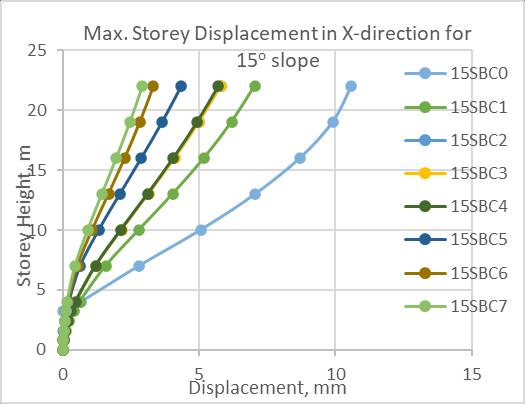
2 minute read
Beam size 300mm x 450mm
from Seismic Performance and Shear Wall Position Assessment of the Buildings Resting on Sloping Ground
International Research Journal of Engineering and Technology (IRJET) e-ISSN: 2395-0056 Volume: 09 Issue: 02 | Feb 2022 www.irjet.net p-ISSN: 2395-0072
In cases SBC5 to SBC7, the base shear along both the direction remains same as the structure is almost similar in plan along both X & Y direction, i.e., Shear walls are distributed uniformly on all side.
Advertisement
With increase in slope (from 15o to 25o), the base shear of the structure increases for all cases i.e.,
SBC0 to SBC7. This is because as the slope of the increases the dead load of building will also increases.
Fig. -10: Base Shear Reactionfor15:Slopes

Fig. -11: Base Shear Reactionfor20:Slopes Fig. -12: Base Shear Reaction for25:Slopes

Storey Drift Ratio
Storey Drift reduces from SBC0 to SBC7
Storey drift along X-direction is less when compared to Storey drift along Y-direction.
Storey Drift Ratio for the first floor is very much higher compared to all other floors, this is due to the short column effectbelow the first floor.
Storey drift ratios for SBC2, SBC3, and SBC4 have similar values as seen in the graphs above.
With the introduction of Shear wall, the storey drift ratio drastically reduces particularly in the bottom stories along both X & Y direction.
It is seen that below 1ststory level, the variation in storey drift ratio is very irregular. This is been reduced considerably by introducing the Shear walls.
However, along Y-direction, the storey drift ratio is very high and variation is highly irregular compare to that of along X -direction from SBC0 to SBC4 (irrespective of inclination of slope of the ground) this may be due to the absence of Shear wall along Y direction in those cases.
For typical case of ground with 20oslope, the max. storey drift ratio at 1stfloor level for SBC1 to SBC4 compared to SBC0 are 73.49%, 58.67%, 59.15% & 41.2% for X direction and 72.32%, 81.25%, 87.5% & 83.93% for Y direction respectively (Fig-15 & 16).
For cases SBC5 to SBC7, the storey drift ratio considerably decreases and highly irregular variation in storey drift reduces which can seen in from Fig 13 to 18.This may be due to presence of
Shear walls on both X &Y directions.




